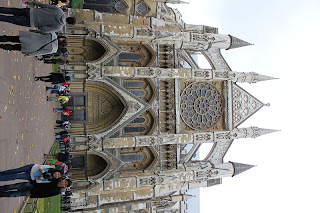After our picnic lunch, we snapped some photos of Westminster Abbey (which was not open for visitors until later on that afternoon) and then set off for an afternoon of sightseeing. London is such an incredible city. There is so much to see. It was easy to ignore the hours and hours of walking because we were so distracted by the impressive sights and sounds of the city (and it was easy for Peter to ignore the hours of walking because he took a long nap in the stroller later that afternoon--hooray!). And somehow, though it is a great big city, it doesn't feel stressful or chaotic. It remains charming and exciting.
 |
| Westminster Abbey |
We strolled past Big Ben again and headed across a bridge over the River Thames. From the bridge, we caught an impressive view of the London Eye; a gigantic Ferris wheel that offers a spectacular view of the city.
 |
| The London Eye |
We then trekked through the streets of London in search of Shakespeare's Globe Theater. Shakespeare's Globe was quite a hike from the Westminster Abbey, but again, the sights of London--St. Paul's Cathedral and Christmas markets--helped distract us from the long walk. We finally found it, stopped inside to see the ticket office and lobby (and, of course, bathroom and gift shop!) and then snapped some pictures of the outside. The modern day Globe Theater is a replica of Shakespeare's Globe Theater from the 1600s and is located near the site of the old theater. It's hard to imagine that the Shakespeare plays that I read in high school were first acted out in a theater very much like this and not far from it!
 |
| The Globe Theater |
Just around the corner from Shakespeare's Globe Theater was THE London Bridge! London Bridge was very simple and unassuming, but my historian husband informed me of its rich history. Dan said that there has a been a bridge on this site since close to London's founding by the Romans in the First Century...the Romans called the city "Londinium" which is where the name "London" comes from. Dan also said that the familiar nursery rhyme "London Bridge is Falling Down" may refer to an event in the year 1014 when, in an effort to assist the Anglo-Saxons in a war against the Danes, the Norwegian prince Olaf tore down London Bridge and divided the forces of the Danes on either side of the River Thames. The bridge was later rebuilt and, over time, shops and homes were built on top of it. The road going down the center of the bridge was so narrow that the city of London attempted to control traffic on it by regulating that north bound persons/carriages/horses/cargo must use the left side of the road and southbound traffic must use the right side of the road...it is believed that this tradition is the reason why the British drive on the left side of the road! Finally, the south side of London Bridge also displayed sights that were meant to deter traitors to the Crown. Beginning with William Wallace (the Scottish rebel whose story is told in the movie Braveheart) in 1305 and continuing for another 355 years, the heads of traitors were placed on spears on the south end of London Bridge. Among other famous individuals to be displayed in this gruesome manner were St. Thomas More and St. John Fisher who were ordered executed by Henry VIII for their fidelity to the Roman Catholic Church.
We walked across the now humble bridge that has seen so much history over the years.
 |
| Dan posing in front of London Bridge |
 |
| Tower of London |
We stumbled across a Christmas market during our stroll. There were little stands with food, gifts, and entertainment along the street adorned with twinkling lights. We soaked in the sights and sounds of Christmas, something we've greatly missed after living in a Muslim country for over a year. We then stepped out of the chilly night air into a little British pub for dinner. Peter and I relaxing together...Peter sipped a glass of apple juice and mommy had some ale.
We finished our grand tour of London with a tasty Thanksgiving feast: fish and chips (followed by bread pudding)! Yum!
Next stop, the Tower of London! The Tower of London was originally built by William the Conqueror who claimed the throne of England in 1066 after defeating his brother Harold at the Battle of Hastings. Despite its enduring reputation as a place of torture and death, only seven people were executed within the Tower before the World Wars of the 20th century. In the First and Second World Wars, the Tower was again used as a prison, and witnessed the executions of 12 men for espionage. St. Thomas More and St. John Fisher were executed outside of the Tower on Tower Hill, but they were buried in unmarked graves in the churchyard of St. Peter ad Vincula inside the walls of the Tower of London.




No comments:
Post a Comment